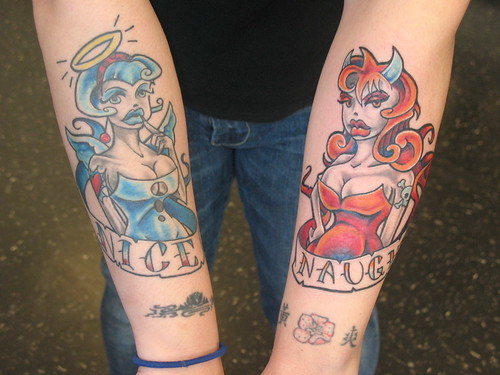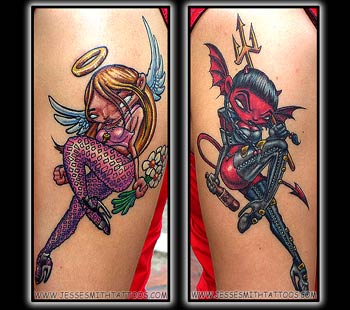


The devil's tattoo refers to the act of ceaselessly drumming one's fingers or tapping one's foot to the point of annoying everyone else in the room. The term is generally used as part of the construction "to beat the devil's tattoo." In short, someone who beats the devil's tattoo is afflicted with an uncontrollable case of the fidgets.
Nowadays, the word "tattoo" generally refers to body ink (based on the Polynesian word "tatau"), but a more archaic meaning of the word stemmed from the military tradition of using a drumbeat or other auditory signal to order soldiers to retreat back to base at night. In this connotation, the word was originally "taptoe." One etymological theory, at least according to the Oxford English Dictionary, is that the word was a shortening of the Dutch phrase "doe den tap toe," meaning "to put the tap to" or "shut off the tap." This referred to the practice of the police shutting off the beer taps in all of the drinkinghouses at closing time, thus marking the end of a soldier's day. It is also possible that "taptoe" is an onomatopoeic word describing the sound of the drum taps that signaled "lights out" in the barracks.
The "devil" part of the phrase may refer to Satan, in that someone who is busy beating the devil's tattoo may inspire his companions to commit evil acts (e.g. strangling) to stop that infernal noise. However, it is more likely a reference to the "blue devils," the hallucinations experienced by a person suffering from delirium tremens, better known as the DTs or alcohol withdrawal. As one of the hallmarks of DTs is uncontrollable tremors or shaking, eventually the term "blue devils" was generalized to include all kinds of fidgeting (someone who constantly fidgeted was said to hear the blue devils). The devil's tattoo may also be related to the old platitude, "Idle hands are the devil's playthings."
The phrase has probably been in colloquial use since at least the 1600s, but it didn't become popular in literature until the 18th and particularly the 19th centuries. It held a fascination for writers of the macabre, and appears often in the work of Edgar Allan Poe and his ilk. The devil's tattoo also makes an appearance in the writing of Sir Walter Scott, Honore de Balzac, Edward Carpenter, Joseph Sheridan le Fanu, and G. K. Chesterton, among others.
Alas, the devil's tattoo is falling out of favor in contemporary times. When I was a fidgety little girl, it was one of my grandmother's favorite sayings, usually as part of a stern admonition to cease and desist, and often followed by an empty threat to "smack the blue devils" out of me. However, when I recently mentioned the phrase to a drummer friend (he has a sometimes annoying habit of hammering out a beat on any available surface, as drummers are wont to do), he accused me, in no uncertain terms, of pulling it out of my ass.
Source : http://everything2.com/user/perhapsadingo8yrbaby







No comments:
Post a Comment